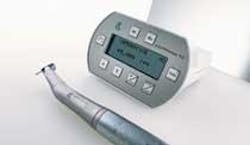Ladies and gentlemen, start your handpieces!
by Brad Durham, DMD
Torque, speed, balance — these adjectives sound like they belong in an article about high-performance race cars rather than to a dental instrument. Many of the same qualities that make a car exceptional also can move a dental practice into high gear. Electric handpieces offer both the dentist and the patient amenities that improve patient care and perception.
Leave the motor sounds at the race track
The burs in the electric handpieces turn at a uniform speed because of high-quality bearings and tight chucks. The handpieces are quieter, reducing patient anxiety and that aural (not oral) stereotype of the irritating sound associated with the traditional dental drill. Reduced “chatter” and vibration in the mouth is very helpful, especially when removing old metal-based restorations or prepping for crowns and bridges. That translates to reduced patient anxiety and increased referrals when word gets around that you are a “smooth operator” when it comes to dental procedures. Besides being smooth, patients will also appreciate how “cool” you are. These handpieces cool the tooth better by expelling water from multiple ports, increasing the patient’s physical comfort and better protecting the tooth’s vital structures. New optics in the handpiece provide a better view of the dentition, and are durable under the most rigorous sterilization techniques.
Facilitate smoother operation
Dentists need the TLC that an electric handpiece provides. Consistently high torque throughout the entire speed range distinguishes an electric motor from an air-driven high- or low-speed handpiece. This allows us to produce precise, defined, smooth, and finer margins, which result in better impressions and perfectly fitting indirect restorations from the laboratory. The reduced vibration that is so important to the patient also results in increased comfort, less hand fatigue and cramping due to less vibration to the dentist’s hand, as well as less strain on the wrist, shoulders, and neck. To accommodate many different procedures, speed can be accurately controlled through the speed selections on the control box. We can adjust for minimum or maximum RPMs and torque and rely on auto-reverse for specialty applications.
Reduce pit stops
Besides the patient and the dentist, the electric handpieces appeal to the “business” side of the practice. The brushless technology inside the electric handpiece is based on magnets. While the carbon brushes in a conventional brush motor need to be replaced because of wear after a certain time, electric handpieces steer clear of the repair shop longer. Brushes also produce carbon dust that needs to be cleaned out of the motor. While electric handpieces do need repair sometimes, it is much less frequent. Some high-speed attachments will need ball bearings and gears in the handpiece head exchanged every so often, depending upon usage.
Increase performance capability
In a world where time is of the essence, the snap-on attachments save time, and increase efficiency, function, and flexibility, which shortens the time patients spend in the dental chair and frees up time for additional patients.
Everyone in the office will be revved up about your electric handpieces, and because of the lower anxiety level and increased comfort, the patients’ drive for treatment will be increased. The electric handpiece’s torque, speed, and balance will help steer you toward an exceptional dental practice so you can cross the finish line ahead of the pack.
Dr. Brad Durham has practiced dentistry for 25 years with an emphasis on the treatment of head, neck, and facial pain, dental cosmetics, and complex dental reconstruction. His practice combines art, science, and technology with personalized care. He is a clinical and featured instructor at the Las Vegas Institute, and was the first in the world to earn the LVI Mastership award for esthetic reconstruction. Dr. Durham teaches a series of courses titled “The Niche Practice” at LVI and his home in Savannah, Ga. Contact him at [email protected] and www.nichepractice.com.

